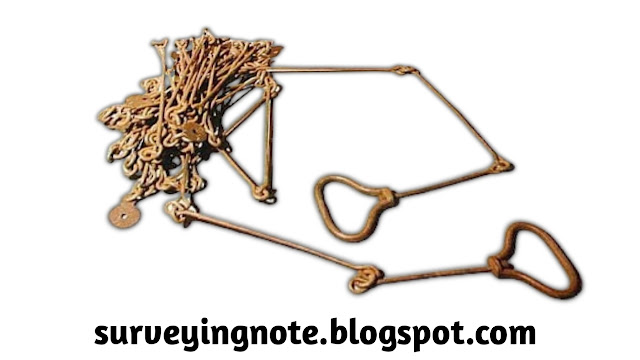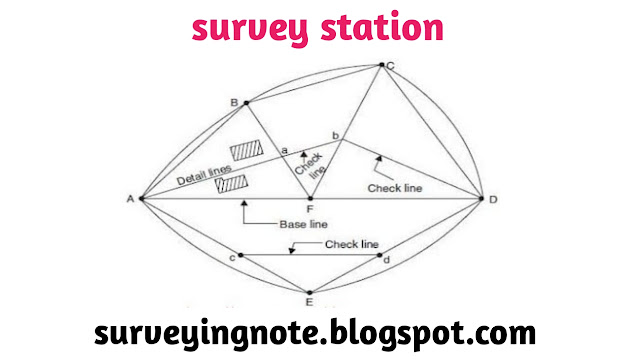CHAIN SURVEYING
PRINCIPLES OF CHAIN SURVEYING :
It ought to be noticed that plotting triangles requires no rakish estimations to be made, if the three sides are known.
Chain surveying is recommended
when --------
1 The ground surface is more or less
level,
2 A small area is to be surveyed,
3 A small-scale map is to be prepared,
and
4 The formation of well-conditioned
trangles is easy.
Chain surveying is unsuitable
when ---------
1 The area is crowed with many
details,
2 The area consists of too many
undulations,
3 The area is very large, and
4
The formation of well-conditioned triangles becomes difficult due to obstacles.
Survey Station :
Survey stations are of two kinds
- Main Stations
- Subsidiary or tie
Main Stations :
Primary stations are the finish of the lines, which order the limits of the review, and the lines joining the fundamental stations reviewed the principle overview line or the chain lines.
Tie or subsidiary lines :
A tie line joints two fixed focuses on the fundamental review lines. It checks the exactness of studying and to find the inside subtleties. The situation of each tie line ought to be near certain highlights, for example, ways, building and so forth.
Base Lines :
It is the fundamental and longest queue, which goes around through the focal point of the field. The various estimations to demonstrate the subtleties of the work are taken as for this line.
Check Line :
A registration additionally named as a proof-line is a line joining the summit of a triangle to some fixed focuses on any opposite sides of a triangle. A registration is estimated to check the precision of the system. The length of a checking line, as estimated on the ground ought to concur with its length on the arrangement.
Offsets :
Counterbalances are the sidelong estimations from the gauge to fix the places of the various objects of the work as for the pattern. These are commonly set at right edge counterbalances. It can likewise be drawn with the assistance of a tape. There are two sorts of counterbalances:
1.Perpendicular offsets.
2.Oblique offsets.
The measurements are taken at right angle to the survey line called perpendicular or right-calculated balances. For setting opposite counterbalances any of the accompanying techniques is utilized:
Swinging
Utilizing cross staffs
Utilizing optical or crystal square
Opposite Offset by Swinging:
The chain is extended along the review line. An associate holds the finish of the tape on the article. Assessor swings the tape on chain line and chooses the point on the chain where counterbalanced separation is the least (Fig. 12.13) and notes chain perusing just as balance perusing in a field book on a flawless sketch of the article. Opposite Offsets Using Cross Staffs.
Figure 12.14 shows three distinct kinds of cross staffs utilized for setting opposite counterbalances. Every single cross staff are having two opposite lines of sights. The cross staffs are mounted on a stand. The principal view is set along the chain line and without upsetting fixing point view is checked to find the article. With open cross staff (Fig. 12.14 (an)) it is conceivable to set opposite just, while with french cross staff (Fig. 12.14 (b)), an even 45º point can be set. Flexible cross staff can be utilized to set any edge additionally since there are graduations and upper drum can be pivoted over a lower drum.
Swinging
Utilizing cross staffs
Utilizing optical or crystal square
Opposite Offset by Swinging:
The chain is extended along the review line. An associate holds the finish of the tape on the article. Assessor swings the tape on chain line and chooses the point on the chain where counterbalanced separation is the least (Fig. 12.13) and notes chain perusing just as balance perusing in a field book on a flawless sketch of the article. Opposite Offsets Using Cross Staffs.
Figure 12.14 shows three distinct kinds of cross staffs utilized for setting opposite counterbalances. Every single cross staff are having two opposite lines of sights. The cross staffs are mounted on a stand. The principal view is set along the chain line and without upsetting fixing point view is checked to find the article. With open cross staff (Fig. 12.14 (an)) it is conceivable to set opposite just, while with french cross staff (Fig. 12.14 (b)), an even 45º point can be set. Flexible cross staff can be utilized to set any edge additionally since there are graduations and upper drum can be pivoted over a lower drum.
Field Book :
All perceptions and estimations taken amid chain looking over are to be recorded in a standard field book. It is an oval book of size 200 mm × 120 mm, which can be conveyed in the pocket. There are two types of the book (I) single line and (ii) twofold line. The pages of a solitary book are having a red line along the length of the paper amidst the width. It demonstrates the chain line. All chain-ages are composed crosswise over it. The space on either side of the line is utilized for drawing the article and for taking note of counterbalance separations. In twofold line book, there are two blue lines with a space of 15 to 20 mm amidst each book. The space between the two lines is used for taking note of the chain-ages. Figure 12.17 shows ordinary pages of field books.
Procedure in chain survey :
Observation: The starter investigation of the region to be studied is called surveillance. The surveyor investigates the zone to be studied, surveyor gets ready record sketch or key arrangement.
Checking Station: Surveyor repairs the required no stations at spots from where greatest conceivable stations are conceivable.
A portion of the techniques utilized for checking are:
Fixing extending posts
Driving pegs
Denoting a cross if the ground is hard
Burrowing and fixing a stone.
At that point he chooses the path for passing the principle line, which ought to be flat and perfect as could be expected under the circumstances and should go roughly through the focal point of work.
At that point going streets are fixed on the stations.
In the wake of fixing the stations, anchoring could be begun.
Make running wherever fundamental.
Measure the change and balance.
Enter in the field the book.
Applicability of Chain Survey :
Clearly, chain looking over can't be utilized in all cases. It very well may be utilized if the territory under thought meets the accompanying conditions:
The territory will be genuinely little.
The ground is reasonably leveled.
The territory should be open.
The ground has few and basic subtleties.
| Chain Survey Tools : |
- Chain
- Tape
- Ranging-Rod
- Arrows
- Cross staff
Chain surveying error watch
Introduction to Surveying -- Read
Surveyor Book Buy - Link
QUESTION AND ANSWER :
1 A trangle is said to be
well-conditioned when its angles should lie between
= 300 and 1200
2 Perpendicular offsets my be taken by
setting the right angle in the ratio
=3:4:5
3 Oblique offset consider
=building
4 Number of offset consider
= straight, parallel, zigzag boundary
5 Limiting length of offset
= 15m
6 The size of the field book is
= 20cm
* 12cm
7 Diffarent type of cross staff
= 3 type
8 What the principle of chain
surveying?
= trangulation
9 Chain survey is recommended when the
are is
= simple and fairly level
10 In chain survey, the area is
divided into
= triangles
11 The sketch prepared during
reconnaissance survey is known as the
= index sketch
12 The working principle of the
optical square is based on
= double reflection
13 The field records of the chain
survey is entered in a/an
= field book
14 The chainman who drags the chain is
called the
= leader
15 The ptrliminary inspection of the
area to be surveyed is known as
= reconnaissance survey
16 The limiting length of offset
depends upon the
= scale of plotting
17 The main survey stations are
located on the ground by
= reference sketches
18 For taking an oblique offset which
makes an angle of 450 with the chain line, the instrument used is
the
= French cross-staff
19 If a wooded area obstructs the
chain line then it is crossed by the
= random line
20 A flag is provided on a ranging rod
when the ranging distance exceeds about
=200m
21 A cross-staff is used for
= setting perpendicular lines to
survey line
22 The position of a point can be
fixed more accurately by
= perpendicular offset
23 The main object of running a tie
line is
= to take details of a nearby object
24 Which of the following angles can
be set out with the help of French cross-staff?
= either 450 or 900
Thank You......

















0 Comments:
Post a Comment